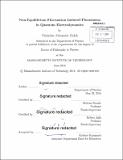| dc.contributor.advisor | Mehran Kardar and Robert Jaffe. | en_US |
| dc.contributor.author | Golyk, Vladyslav Alexander | en_US |
| dc.contributor.other | Massachusetts Institute of Technology. Department of Physics. | en_US |
| dc.date.accessioned | 2014-10-21T17:24:39Z | |
| dc.date.available | 2014-10-21T17:24:39Z | |
| dc.date.copyright | 2014 | en_US |
| dc.date.issued | 2014 | en_US |
| dc.identifier.uri | http://hdl.handle.net/1721.1/91076 | |
| dc.description | Thesis: Ph. D., Massachusetts Institute of Technology, Department of Physics, 2014. | en_US |
| dc.description | 138 | en_US |
| dc.description | Cataloged from PDF version of thesis. | en_US |
| dc.description | Includes bibliographical references (pages 120-129). | en_US |
| dc.description.abstract | We study fluctuation-induced phenomena in systems out of thermal equilibrium, resulting from the stochastic nature of quantum and thermal fluctuations of electromagnetic currents and waves. Specifically, we study radiative heat transfer and Casimir forces by applying the scattering formalism that expresses results solely in terms of the classical scattering matrices of the objects. For example, we obtain exact formulas for the heat radiation emitted by long cylindrical objects, as well as for Casimir forces that arise between them. We apply our results to explore the dependence of these phenomena on size and material properties of cylinders. While the scattering formalism is very general and technically can be employed for arbitrary shapes, in practice it is very time-consuming to apply it to the most experimentally-relevant and complex case of objects at close proximity. We examine easier ways to compute the heat transfer in such case. In particular, we develop a small distance expansion for the heat transfer between gently curved objects, in terms of the ratio of distance to radius of curvature. This expansion allows us to rigorously justify the widely used approach of "proximity transfer approximation", and to quantify corrections to it in the limit of small separation. Moreover, we study the role of surface roughness, and show that it may change the distance dependence of the heat transfer as well as Casimir forces between curved objects at proximity. Finally, as an alternative approach we construct general Green-Kubo relations that connect radiative heat transfer, non-equilibrium Casimir forces and vacuum friction between arbitrary objects to fluctuations in equilibrium which may be easier to consider from the perspective of experiment and simulations. | en_US |
| dc.description.statementofresponsibility | by Vladyslav Alexander Golyk. | en_US |
| dc.format.extent | 129 pages | en_US |
| dc.language.iso | eng | en_US |
| dc.publisher | Massachusetts Institute of Technology | en_US |
| dc.rights | M.I.T. theses are protected by copyright. They may be viewed from this source for any purpose, but reproduction or distribution in any format is prohibited without written permission. See provided URL for inquiries about permission. | en_US |
| dc.rights.uri | http://dspace.mit.edu/handle/1721.1/7582 | en_US |
| dc.subject | Physics. | en_US |
| dc.title | Non-equilibrium fluctuation induced-phenomena in quantum electrodynamics | en_US |
| dc.type | Thesis | en_US |
| dc.description.degree | Ph. D. | en_US |
| dc.contributor.department | Massachusetts Institute of Technology. Department of Physics | |
| dc.identifier.oclc | 892622262 | en_US |
